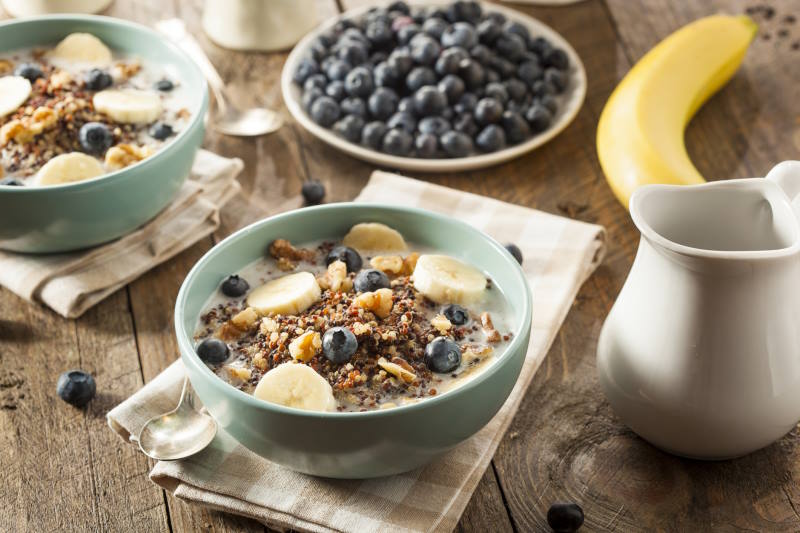5 Benefits of Quinoa (+ 1 Easy Recipe)

If you aren’t familiar with quinoa (pronounced KEEN-wah), you don’t know what you’ve been missing. This pseudo-cereal superfood is a nutritional powerhouse that fits into just about any diet plan. Among the many benefits of quinoa, it’s high in protein and fiber and oh so versatile.
While quinoa is often referred to as a grain crop, it’s neither a grass nor a grain but rather a small seed. That said, it’s prepared the same way grains are, so it can be used in place of grains in a wide variety of recipes.
Where Did Quinoa Come From?
Cultivated in the Andean regions of South America for thousands of years, quinoa was a staple food for the ancient Incans and is still a revered food crop today. It’s been called the “mother grain” but faded into the background as crops like wheat and rice overtook the Americas. Fortunately, quinoa has experienced a powerful resurgence during the last decade or so and is once again sought after as the superfood it is.
Because of the benefits of quinoa, it may be especially useful for vegetarians and vegans, those who avoid gluten, and people interested in managing their weight.
What Are the Benefits of Quinoa?
The benefits of quinoa are many. Here are just some of the benefits cited:
- It’s loaded with protein. What’s more, unlike most plant foods, it’s a complete protein source. That is, it provides all nine essential amino acids. Thus, quinoa helps promote the repair and growth of tissues and helps the body produce key enzymes, hormones, and other chemicals. Because it’s complete, it’s often indispensable for vegetarians and vegans, but it’s a healthy choice for anyone who wants to add more protein to their diet.
- It’s gluten-free, providing a grain-like option for people who are sensitive to gluten, have a gluten intolerance, or have celiac disease.
- It’s loaded with fiber, which can help promote a healthy gut, promote digestion, lower cholesterol levels, and stabilize blood sugar levels. It can also help you feel fuller, which can help you eat less and thus manage weight more effectively.
- It’s rich in nutrients, including:
– Manganese, an essential mineral important for bone formation, blood clotting, and balanced inflammation.
– Magnesium, which is needed for healthy muscle and nerve function, energy production, and protein synthesis. Magnesium is also important for healthy immune functioning and heart rhythm.
– Phosphorus, which is vital for bone and teeth formation. It’s also needed to create ATP in the body to store energy.
– Iron, which is critical for hemoglobin formation. Hemoglobin is the protein in red blood cells that transports oxygen from the lungs throughout the body.
– Folate, which is vital for healthy cell division and is especially important during pregnancy.
– Zinc, a trace element needed for the immune system, protein synthesis, wound healing, and more.
– B vitamins (B1, B2, B3, and B6), which are needed to metabolize foods into fuel and promote numerous healthy functions in the body.
– Vitamin E, an antioxidant vital for protecting cells from damage, supporting immune function, DNA repair, and other functions.Quinoa is also a source of energy-rich carbohydrates to fuel the brain and muscles and polyunsaturated and monounsaturated fats, which are good for the heart.
- It’s a good source of phytonutrients like quercetin, kaempferol, saponins, phytic acid, betacyanin, phenolic acids, polysaccharides, and oxalates, which have various positive effects on the body, such as fighting free radicals (as potent antioxidants) and supporting healthy levels of inflammation, stabilizing blood pressure, improving heart health, promoting gut health, and more.
Quinoa Nutritional Facts
A typical serving of quinoa is around one cup, which provides:
- ~222 calories
- 7.6 g protein
- 3.5 g fat
- 39.4 g carbohydrates
- 5.2 g fiber
It’s worth noting there are slight variations between the different types of quinoa (white, red, black, or tricolor) as well as how the quinoa is cooked. Regardless of which one you choose, know you’ll be eating a food that’s rich in protein, fiber, and nutrients.
Negatives of Quinoa
There are no perfect people and no perfect foods. While quinoa benefits vastly outweigh any negatives, there are a few drawbacks. For instance, quinoa contains saponins. While saponins are natural compounds that positively affect the body, they can also taste bitter or “soapy.” In addition, some people find they cause some stomach discomfort. This issue can usually be reduced or eliminated by simply rinsing quinoa before you cook and eat it.
Quinoa also contains oxalates, which are sometimes called “antinutrients” because they can decrease the absorption of some nutrients. It’s also not recommended for people with kidney stones. That said, “antinutrients” appear to be less problematic than some have suggested.
Finally, because of its popularity, the cost of quinoa has increased over the years. You may want to stock up when you find it on sale or look for deals when you buy it in bulk or online.
How to Prepare Quinoa
Quinoa works in many types of recipes, from breakfast to dinner. For instance, cooked quinoa can be mixed with chopped vegetables in a delicious salad. It can be cooked and put into stuffed peppers instead of rice. It can be served in a stir-fry or added to soup. One of our favorite ways to prepare quinoa is for a simple, nutrient-packed breakfast like the one below.

Ingredients
- 1 cup quinoa
- 1 cup unsweetened coconut milk
- ¼ cup water
- 2 Tbsp maple syrup or honey
- Dash of salt
- ¼ tsp vanilla extract
Instructions
- Rinse quinoa to remove bitter-tasting saponins.
- Add quinoa, coconut milk, water, syrup, salt, and vanilla extract to a medium-sized saucepan.
- Place the pan over medium-high heat and bring it to a boil.
- Once it’s boiling, turn the heat down to low, and place a tight lid on the pan. Cook for 18 to 20 minutes until most of the liquid is absorbed.
- Remove from heat, and allow it to rest for five or so minutes.
- Before serving, fluff up the quinoa.
- Enjoy!
Notes
- Fruits like fresh berries or cherries, banana slices, diced mango or kiwi, dried raisins or cranberries, diced apples or pears, or pomegranate seeds.
- Nuts or seeds, such as almonds, walnuts, pecans, chia or flaxseeds (which can be added when cooking), pumpkin or sunflower seeds, or coconut flakes.
- Spices like cinnamon, nutmeg, cardamom, or more vanilla.
- The zest of a lemon, lime, or orange if you want a little tang.
- A dollop of creamy Greek yogurt.
- Cocoa nibs for a crunchy chocolatey flavor, or you could use dark chocolate shavings.
- A sprinkle of granola for added flavor and crunch.
- Or, skip the sweeteners and top your porridge with a poached egg along with a couple of slices of avocado, and season with your favorite flavors (like everything but the bagel seasoning) for a more savory breakfast.
- You could also stir in your favorite protein powder to make it a higher-protein breakfast.
Nutrition
Including quinoa in the diet celebrates culinary traditions combined with loads of nutrition and a delicious flavor. And one of the biggest benefits of quinoa is its versatility. It can be used in sweet or savory meals with plenty of options to create a meal you’ll love.




